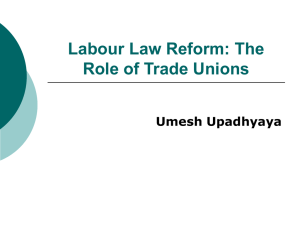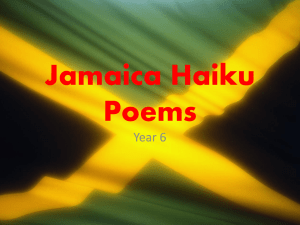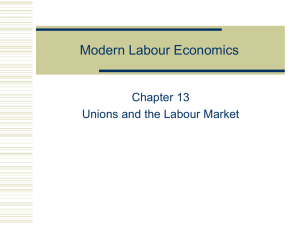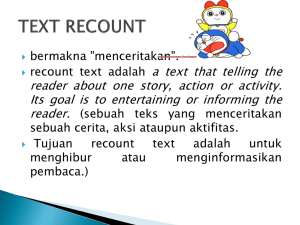Presentation - Jamaica Teachers` Association
advertisement
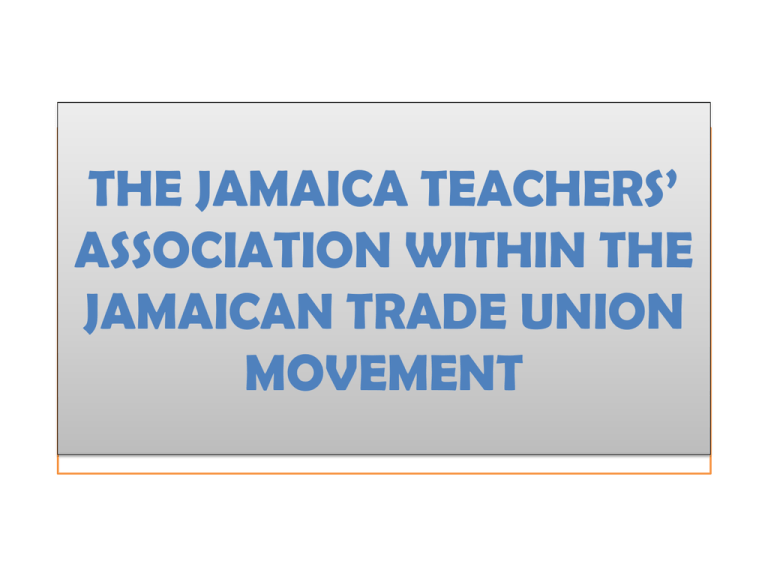
THE JAMAICA TEACHERS’ ASSOCIATION WITHIN THE JAMAICAN TRADE UNION MOVEMENT ……….Why are we here today? “ a battle never stays won. Rights and freedoms have to be constantly defended.. (and) won again and again. Unfortunately, history places no obligation on those who have not lived through its incidents; memories are short and issues once resolved have an ugly habit of reappearing as if they had never been considered before.” - Sybil Shack, President, 1960 61 2 Early trade unionism in the Anglophone Caribbean stemmed from growing working class consciousness and desperation of its deplorable working and living conditions – low and irregular wages, irregular employment, long hours of labour, poor housing and sanitation, deficient water supplies, inadequate medical services, and lack of educational opportunities. 3 WHY LABOUR UNIONS WERE SLOW TO DEVELOP ♦ attitude of the planter class in the decades after Emancipation ♦ the rise of a yeoman peasantry away from the estates ♦ decline of sugar in the period (1838 – 1865) 4 WHY LABOUR UNIONS WERE SLOW TO DEVELOP (CONT’D) ♦ influx of labour from India, China, Europe, North America and Africa reduced the bargaining position of local labour ♦ the plantocractic dominated Assembly would not countenance any form of labour organizations and used their legislative power to prevent the development of organized labour. 5 EARLY TRADE UNIONS Among the earliest unions to emerge were: ♦ Carpenters, Bricklayers and Printers Union (commonly called the Artisans’ Union) organized in 1898 This union disintegrated by 1901 as a result of the depressed economic conditions and internal dissentions over the auditing of accounts EARLY TRADE UNIONS (CONT’D) ♦ Painters’ Union (another artisan union) founded in 1907 with Marcus Garvey as a member ♦ The Tobacco Workers’ Union and the Jamaica Trades and Labour Union, No. 12575 (later No. 16203) of the American Federation of Labour (AFL) 7 EARLY TRADE UNIONS (CONT’D) ♦ Longshoreemen’s Union (representing dock workers) founded by Bain Alves in 1919 This union advocated for the legal recognition of trade unions. Governor Sir Leslie Probyn (June, 1918 to August, 1924) was sympathetic to the workers’ cause and enacted in October 1919, a Trade Union Ordinance which freed trade unions from the possibility of criminal charges of conspiracy to which they were subject until then. 8 EARLY TRADE UNIONS (CONT’D) The ordinance, however, did not protect unions against liability from damage resulting from strikes, nor did it legalize peaceful picketing. 9 THE RISE OF TEACHER TRADE UNIONISM Early Teacher Unions: - Teachers were the first group to organize into Associations/Unions; - The earliest forms of teacher organizations were “Educational (Teachers) Associations; - Educational (Teachers) Association started in 1882; 10 THE RISE OF TEACHER TRADE UNIONISM (CONT’D) - By 1894 there were 15 Teachers’ Associations formed on parish basis (one was a Women Teachers’ Association, organized in Kingston and St. Andrew and was separate and distinct from the Kingston Teachers’ Association and the St. Andrew Teachers’ Association, through the women teachers were active in both parish associations); - All but 1 (the WTA) was dominated by Churchmen. 11 MANDATE OF THE EARLY EDUCATION (TEACHERS) ASSOCIATION ◊ Promote the efficiency of the schools; ◊ Advance the interest of teachers by holding stated meetings for essays and discussions upon educational topics; ◊ Circulating among members educational periodicals and the most improved works on the art of teaching, etc; ◊ Bringing teachers together in centres throughout the country at regular intervals; 12 MANDATE OF THE EARLY EDUCATION (TEACHERS) ASSOCIATION (CONT’D) ◊ Promote discussions on problems of the classrooms; ◊ Fostering of occupational awareness. 13 LIMITATIONS OF THE EARLY ASSOSICATIONS ♦ They were usually dominated by churchmen who had their own occupational concerns; ♦ Churchmen were usually the operators of the schools and the employers of the teachers; ♦ There were usually conflicts within these parish-based organizations as membership cut across denominational lines. 14 THE JAMAICAN UNION OF TEACHERS ▪ The Jamaican Union of Teachers (JUT) came into existence on March 30, 1894; ▪ The JUT was therefore the first trade union organization to be established; ▪ The JUT was dominated by Headmasters/ Headmistresses of Primary (Elementary) Schools; 15 THE JAMAICAN UNION OF TEACHERS (CONT’D) ▪ Most of these Head Teachers were in fact clergymen (Missionaries) assisted by their spouses (wives). ▪ Many of these schools were small (attached to the vestries of the churches). There were 962 registered schools in 1894/5. 16 FACTORS INFLUENCING THE FORMATION OF THE JAMAICA UNION OF TEACHERS (JUT) The 1886 Report of Education Commission stirred a vigorous debate in Jamaica. The Report recommended (inter alia) that the state should: subsidize teachers’ housing; institute a scheme of superannuation; assume full financial responsibility for elementary education; 17 FACTORS INFLUENCING THE FORMATION OF THE JUT (CONT’D) school attendance be made compulsory; establishment of a central Board of Education; an education tax be raised to pay for these reforms. 18 PASSAGE OF THE ELEMENTARY AND SECONDARY EDUCATON LAWS - 1892 The various teachers organizations had very little input in the passage of these pieces of legislation which were not in their favour; The Jamaica Exhibition held in Kingston - 1891 This exhibition made an impression on the legislators, planters, churchmen and teachers that there was great advantages to be gained from technical and agricultural education; 19 PASSAGE OF THE ELEMENTARY AND SECONDARY EDUCATON LAWS – 1892 (CONT’D) ♦ The Exhibition added a new dimension to the debate – the country needed technical and agricultural education if it was to progress. The new demand was that these subjects be added to the curriculum; - The new Education Law failed to address the interest of teachers, viz: 20 PASSAGE OF THE ELEMENTARY AND SECONDARY EDUCATON LAWS – 1892 (CONT’D) the position of the teacher, vis a vis his immediate employer, the school manager, remained unchanged; the teacher could expect little protection in his work; his salary continued to be dependent on his results’ achieved at the end of the year as determined by the Inspector who would examine the pupils; 21 PASSAGE OF THE ELEMENTARY AND SECONDARY EDUCATON LAWS – 1892 (CONT’D) ♦ no provision for a pension was provided in the 1892 law; ♦ the recommendation for free education was adopted but the teachers’ recommendation for compulsion of attendance was omitted. This was to have an effect on teachers salaries; ♦ the law strengthened the position of the church in education by retaining ownership and control of the schools in the church while publicly funding education; 22 PASSAGE OF THE ELEMENTARY AND SECONDARY EDUCATION LAWS – 1892 (CONT’D) the Central Board of Education established under the law, had no teacher representative while the various denominations enjoyed direct representations; the churches were the only groups recognized by the state as authority on education; Governor Blake’s attack on the elementary school teachers as being ‘incompetent’ based on the Report of the Superintending Inspector of Schools (1891) that of the 850 head teachers in the country receiving grants-in-aid only 115 were of the first of the 5 grades into which the teachers were classed. 23 PASSAGE OF THE ELEMENTARY AND SECONDARY EDUCATION LAWS – 1892 (CONT’D) ♦ At a meeting at Rock River, Clarendon, a number of teachers expressed their bitterness at the Governor’s remarks. Many letters were sent in the Gleaner by teachers protesting Blake’s remarks and calling on all teachers to write, so as: “to ventilate our opinions on the educational questions of the day. If we do not speak now, then it may be justly said of us that we are a body of incompetent men.” 24 PASSAGE OF THE ELEMENTARY AND SECONDARY EDUCATION LAWS – 1892 (CONT’D) (Daily Gleaner, (23 March 1892), p.3) A prominent member of the KTA Major Plant, placed an advertisement in the Gleaner encouraging teachers to send their views to the KTA so that they could be more coherently and systematically expressed and channeled to the appropriate authorities. 25 THE IMPACT OF THE JAMAICA UNION OF TEACHERS • Although it was Major Plant of the KTA who first advocated a unity of the various teachers associations, the leadership initiative was seized by J.A.Mason and W.F. Bailey of the Manchester Teachers’ Association; • A circular was dispatched to 100 teachers inviting them to a “Teachers’ Convention” in Spanish Town, Friday, March 30, 1894; 26 THE IMPACT OF THE JAMAICA UNION OF TEACHERS (CONT’D) • The meeting adopted the resolution creating the Jamaica Union of Teachers (JUT); • The JUT was modeled on that of the British National Union of Teachers; • Within the first 5 years membership was 1733 teachers; (most of the 912 elementary schools had 1 teacher); 27 THE IMPACT OF THE JAMAICA UNION OF TEACHERS (CONT’D) • All elementary schools were represented; • All parishes constituted Associations. The original parish Teachers Associations became subsumed under the umbrella of the JUT. 28 THE JUT AND POLITICS • In 1866, Jamaica became a crown colony. That is, it was governed directly from Britain by a Governor chosen by the Colonial Office, and accountable to it for the governance of Jamaica; • There was a Legislature Council nominated solely by the Governor and advised by a local Privy Council; • In 1884, a measure of representation was reintroduced. Nine (9) elected members were allowed in the Legislative Council on a restricted (land tenure) franchise; 29 THE JUT AND POLITICS (CONT’D) • In 1895, the number of elected members was increased to 14. From this point onward, there were always three (3) elected JUT members of the Legislative Council; • The JUT had a voice consistently in matters affecting education but this was balanced by the influence of the church; • The leaders of the Union continued to cultivate a good relation with the church and bishops of the many denominations were among its rank and file and clergymen were members of the Union. 30 THE JUT AND THE WIDER UNION MOVEMENT • There was not much of an alliance between the Union and other local “trade unions” before the 1930’s. The JUT was however affiliated with the British National Union of Teacher in 1926 and later was a founding member of the Caribbean Union of Teachers (founded August 1935); • Officials of the JUT met on occasions with the leadership of the Longshoremen’s Union on issues relating to legal recognition of Trade Unions. The lobby by both bore fruit in the 1919 Trade Union Ordinance (Law 37 of 1919); 31 THE JUT AND THE WIDER UNION MOVEMENT (CONT’D) • Even before the labour riots of 1938 the leadership of the JUT sought to organize peasants in numeracy and literacy classes and worked through the JAMAICA AGRICULTURAL SOCIETY to improve the welfare of the peasants and labourers. • The Executive of the Union made submissions before the Moyne Commission which visited Jamaica in 1939 following the labour riots. 32 THE JUT AND THE WIDER UNION MOVEMENT (CONT’D) In his submission before the Commission, H.E. Allan (who was to become the first Minister of Finance after the 1944 elections) raised the issue of low educational standards, compulsory attendance and the inability of the children of the peasantry to attend school regularly. ▪ The JUT passed a resolution welcoming the formation of the Bustamante Industrial Trade Union (BITU) (registered January 23, 1939) and hailed the efforts of Alexander Bustamante in lobbying for 33 THE JUT AND THE WIDER UNION MOVEMENT (CONT’D) increased wages and benefits for the sugar workers claiming: “…these benefits will redound to the betterment of the children in our schools…” ▪ Members of the Executive were active in the establishment of the People’s National Party (PNP) in September, 1938. This was simply the continuation of the JUT’s tradition of maintaining links with the influential bodies e.g., The Jamaican Progressive League; the P.E.N. Club, etc.; 34 THE JUT AND THE WIDER UNION MOVEMENT (CONT’D) • The formation of the Trade Union Congress (TUC) (22 July 1949 ); and the National Workers Union (NWU) (October 17, 1952); witnessed the growing strength of the labour movement and a greater level of interaction between the Unions; • Union – Party affiliation grew as the political parties used the Unions to mobilize support among the new electorate; • There were signs, however, that the membership of the JUT was split over the issue of the JUT as a 35 THE JUT AND THE WIDER UNION MOVEMENT (CONT’D) trade union or as a professional organization – as greater use of the strike tool to enforce demands was employed by the labour unions; ▪ Between the 1940’s and early 1960’s the JUT increasingly distanced itself from the strike as a means to extort benefits for teachers; ▪ There was no central body of Trade Unions – e.g. Trades Union Congress of Great Britain or the 36 THE JUT AND THE WIDER UNION MOVEMENT (CONT’D) American AFL-C10. This gave rise to a considerable amount of rivalry in certain sectors of economic activity and consequent claims for bargaining rights. ▪ Even among teachers, four (4) additional unions emerged during the 1950’s and 60’s, viz: - Association of Assistant Masters and Mistresses representing teachers in the traditional grammar schools; 37 THE JUT AND THE WIDER UNION MOVEMENT (CONT’D) • Association of Head Masters and Head Mistresses; • Association of Teachers in Technical Institutions; • Association of Teacher Training Staffs These Unions reflected the division in the teaching Fraternity and made the settlement of wage claims extremely difficult. 38 ATTEMPTS TO ORGANIZE LABOUR UNIONS • Joint action was taken in a number of areas: Joint Industrial Council (for various industries e.g. sugar, building, etc); ▪ The formation of the Jamaica Employers’ Federation (JEF) on May 10, 1957 not only reflects the effectiveness of labour unions, but also sends a sharp message to the unions of the need to organize under a single umbrella; 39 ATTEMPTS TO ORGANIZE LABOUR UNIONS (CONT’D) • The chance came in the 1980’s when faced with government cutbacks and lay-offs, the Joint Trade Union Research and Development Centre (JTURDC) was created; later it became the Jamaica Confederation of Trade Unions (JCTU). The JTA joined in 1994. • The Teachers Union led the way. In 1964, seven decades after the formation of the JUT, the Jamaica Teachers’ Association (JTA) was the product of the merger of the five (5) teachers unions. This merger came about when a resolution creating an interim Joint Executive of Teachers’ Associations (JETA) was established to work out all the legal and organizational issues involved in the creation of a single teachers union. 40 ATTEMPTS TO ORGANIZE LABOUR UNIONS (CONT’D) . In 1959 during the Presidency of the indomitable Edith Dalton-James, the Joint Executive of Teachers’ Association was formed to spearhead the unification process. . Teachers had more common interests uniting them than the sectional interests their groups represented. The national concerns also dictated unity. And just as in the 1890s when the 15 Teachers’ Associations coalesced to form the JUT in the face of perceived threats posed by the Elementary and Secondary Education Laws, so in the 1960’s that teachers, in response to a common threat, found renewed strength in their unity. Sectional interests gave way to the greater common cause. 41 ATTEMPTS TO ORGANIZE LABOUR UNIONS (CONT’D . In November 1963, the Joint Executive of Teachers’ Associations gave way to the new National Executive of the Jamaica Teachers’ Association. 42 ATTEMPTS TO ORGANIZE LABOUR UNIONS (CONT’D) The Jamaica Teachers’ Association representing 85% of the teachers in the public sector from Infant School to University, now stands proud as a symbol of unity and strength. Long live the JTA! 43 APPENDICES 1. Average Annual Expenditure of 5 year periods: £ 1862 – 1866 3700 1867 – 1871 7200 1872 – 1876 19300 1877 – 1881 23000 44 APPENDICES (CONT’D) 2. Result of School Examination: Year Able to Read and Write Able to Read Only 1861 50,726 68,333 119,059 1871 71,076 81,398 152,472 1881 115,418 115,268 231,268 Total 45 APPENDICES (CONT’D) 3. School Attendance and Expenditure on Education; No. of Schools No. of Pupils on books No. of Pupils in Avg. Attendance Cost per Pupil in Avg. Attendance Population 913 92,135 52,983 3.94 639,491 Percentage of Revenue on Primary Education 6.0 46 THANK YOU! 47



